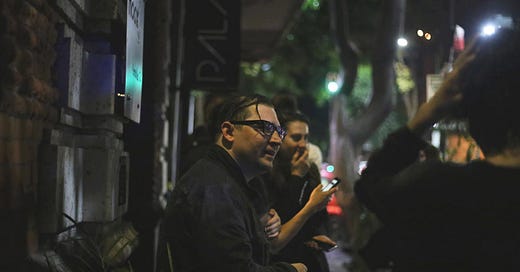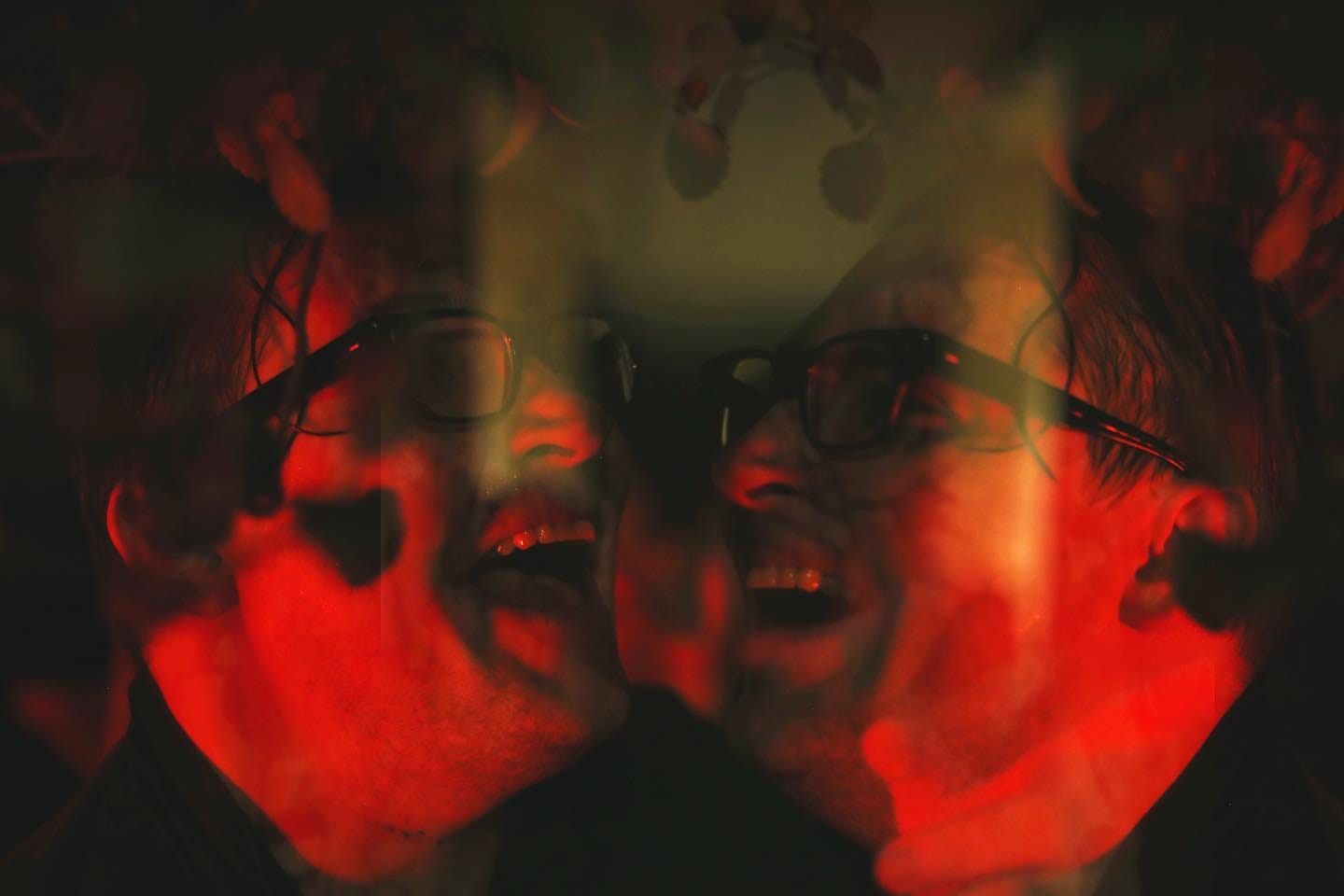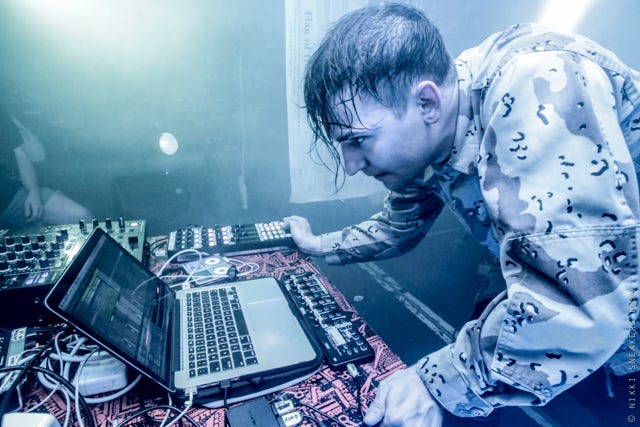Re-release of 'Vatican Shadow - Keeping the Underground Alive.' A conversation between Pat Aliyeva and Dominick Fernow.
It’s time for a Long Read edition of the NSNS newsletter. Glad you could join us.
Today’s lead story is a special one. It was among the first stories we ever released on NSNS, and it remains just as powerful today. This is a conversation between Pat Aliyeva and Dominick Fernow, also known as Vatican Shadow—an exchange so vivid, so alive through the brilliant writing of Pat Aliyeva, that you feel as if you’re in the room with them.
What makes this dialogue remarkable is its intimacy. It’s not just an interview but a meeting of minds, where two artists open up through their personal philosophies, experiences, and reflections on life. Dominick, in particular, has a striking clarity in how he perceives his work, unraveling its meaning through an intricate process of thought and deconstruction.
Revisiting this piece gives me much to reflect on. It exemplifies the kind of conversations I value deeply—whether engaging in them myself or, as in this case, reading them.“How a conversation that touches upon fear, war and connecting to people in a world that lacks empathy, results to be the most uplifting thing ever.”
With that, here’s our slate:
1) Vatican Shadow - Keeping the Underground Alive by Pat Aliyeva.
2) Two movie recommendations.
Now, let’s go!
1) Vatican Shadow - Keeping the Underground Alive.
Picture by Rezzie
Dominick Fernow (aka Vatican Shadow) arrives at Yu Yu a couple of hours before his gig. We meet in the hall and I show him downstairs to the club. We leave his suitcase in the dj booth and go upstairs to the record shop to have a chat. Dominick looks tired. His touring schedule is pretty tight. He talks about the gig he had last night, he was playing for a crowd of ten people. He talks about places. Nice and not so nice. South of the US is not that nice, New York is good though.
We talk about DJing and about “killing the vibe”. Dominick says it did happen to him quite a few times. “And how do you know you killed the vibe?”, I ask. “Oh, you can tell! You can always tell!” he laughs. “But such things happen, it’s ok, it can’t always be the same or always good”.
We accommodate our chairs behind the counter and lock the shop.
Pat: I always wanted to ask, what’s the thing with dadaism? Were you inspired by dadaist philosophy at some point?
Dominick: Yes, but I would say I am more of a futurist…- he puts a cough drop in his mouth.
P: Have you been using any of the dadaist methods when making your art? Have you been using cut-ups?
D: Yes, of course!
“Is Vatican Shadow a cut-up?”, I am about to ask, but then I decide not to. Something is telling me this question isn’t quite polite really.
P: That’s what I thought! Your friend and collaborator Nico Vascellari was using it in his performances too, wasn’t he? How did you actually meet Vascellari? And how did the two of you end up performing at an Italian Vogue party?
D: Which one? - he smiles.
P: Rome, I reckon?
D: Maxxi museum, probably.
P: Yes, right! There were a lot of fancy people there, smiling at the camera and all that, I’ve seen photos! And then there were the two of you performing…
D: Are you trying to say we were not fancy? - he asks with a slight laugh.
P: No, I didn’t say so! But, seriously, how did you end up performing there?
D: It was Nico’s idea. He is a professional infiltrator and a very talented artist. I met him in New York. He came to my shop, Hospital Productions, and asked if he could take some photos for a magazine. It was GQ i think…I remember, when those photos got published in the magazine, they put it as HOTEL PRODUCTIONS…
I’ve been racking my brain in search of the right word to describe Vascellari’s work and finally Dominick gave it to me. “Yes, infiltrator is exactly the word!” I exclaim.
Picture by Rezzie
D: You know, he is involved in various projects with big fashion brands...
P: Yes, he works with Fendi, making prints and stuff...
D: ...But he always finds a way to do something controversial, he really is an infiltrator.
Dominick gives me his next-question-please-look and that’s how I know I can go on.
P: You have a lot of monikers, tons of them, I can’t even remember all of them...
D: Yeah, me neither!
Of course, that’s not true. By this time I also realise that Dominick Fernow has a very good sense of humour and is unfailingly polite.
P: But why Vatican Shadow? It’s probably the most famous one, right?
D: Well, that’s not for me to say, wouldn’t be able to judge that.
P: But if you are playing live or djing as Vatican Shadow, you do know people will come to see the show, cause they know you...
D: Not necessarily. I just played a show last night, there weren’t very many people there, you can never assume anything. The music business is ruthless. My friends and I talk about this all the time. You’d be 20 years in your career and still playing rooms for 10 people, you know? There are no guarantees. The only guarantee is if you’re passionate about what you are doing. Otherwise there is literally no point. Because every time you do something you’re gambling.
P: And why Vatican Shadow?
D: Ehmmm…That’s a complicated question, that I don’t usually answer - he says with a sigh.
P: But quite an interesting one though. I mean…Why VATICAN shadow?
D: Ambiguity is essential to the project. There are people who take a lot of issues with ambiguity here. I personally know many people, some of them journalists, that do. That only reiterates its importance, especially in decline of journalism in the last 15 years. You know, the purpose is not to tell people what to think, the purpose is to present a familiar story, the story of militarism and the story of post 9/11 era, when most people were bombarded through media…- he resumes after a pause - My mission is to recontextualise the story on an individual basis through ambiguity. When you are presented with a familiar story, but the sequence is out of order, that is a device which, I hope, can lead people to drop some of their prejudices and think twice about what they are already bringing to this story. So, for this reason, the ambiguity is essential to the project. And its ultimate purpose in trying to break apart the assumptions that many people carry, when they approach a subject like that, is to ultimately overcome fear. The project is really about fear and overcoming it.
P: Fear of what?
D: Fear of…the self. Well, as a person who suffers from anxiety disorders...Which is the process in the brain, that is based on the visual side of the brain. it’s all about your imagination, about what’s not happening, it’s about what-if scenario, what if this happens, what if that happens?
P: A lot of people suffer from it, anxiety is somewhere in the future or in the past, never in the present, we are always in the future or in the past, that’s where anxiety comes from…- looks like I suddenly start talking about myself.
D: But anxiety is different from an anxiety disorder. AD is a process in the brain, which accelerates what isn’t happening, but what could happen, it is connected to the visual side of the brain, but the physical manifestation of it is a panic attack, which is just a release of adrenaline in your body. It's shortness of breath and it says that you are in danger and its either fight or flight. So, of course, everyone has anxiety but an anxiety disorder is something that is more specific, so the whole goal is to try and learn to live in the moment. There is much stress that accompanies doing this stuff, but it does occasionally have a potential to be a transcendent experience that forces you to be in the moment. And that is when you are able to overcome all of the obstacles that are in your way, you know, like a different soundsystem every night, a different crowd every night, the weather...There are all these things that are out of your control. And when it goes well and you can manage them, eventually, you may be able to reach a state where you stop thinking about all those things. And that’s where the audience comes in, because the audience is an extremely critical factor in all this. I see it as a collaboration between the performer and the audience.
I don’t know how many times Dominick has already been talking to people about this, but he is doing it very well. You don’t even have to ask. He certainly is very engaged, collaborative and supportive. Maybe a little bit guarded still. He goes on.
D: I don’t see it as ME playing for THEM or THEM watching ME, it’s something that WE are in together. And it can either go badly or it can go well, depending on what happens, but the intention is to try and break down a little bit of the expectation, of what is associated with club culture for example, what’s expected of the dj or an artist, and in some places to do that through exaggeration.
P: In what sense?
Vatican Shadow: “I still love the music, I don’t like the culture but I like the music.”
D: By making a fool of yourself. By at least creating the impression that you don’t care. By engaging with the crowd. And if you can, well, it’s a risk, because you can come off like an asshole and you can come off like a fool, but if you can get the audience to live the moment by kind of re-establishing the terms of what happens or what’s expected of them and of me or the artist, if you can do that and get them to be actually aware of what’s happening, rather than assume what will happen... or what they think should happen, and what they think their role in it is, then, in theory, if you can get past that by re-establishing the terms of the agreement between the audience and the performer, then, may be, you can let go of some of those assumptions, and prejudices, and presumptions, and expectations, that they have brought.
Now Dominick is really engaging and he doesn’t look guarded anymore. It’s all going so suspiciously well, that I get paranoid the recorder might not be recording our conversation. I look at it and, obviously, everything is ok, but I pause it, start it again, check it, all good, pause it again...Dominick is talking about how the Internet and social media are pure evil, then he asks “Are you ok? Is everything fine? Are you sure?”
P: Yes, absolutely! But wait, why are you so against the Internet?
D: It destroyed everything.
He always has two versions of an answer, a shorter one and, as I would call it, a proper one. We are up for a treat here, I can tell. So I immediately request “the proper one”.
P: Like what?
D: Let’s say, you heard about a band, for example Bad Brains. You could hear about the band and how important they were. Maybe you saw guys wearing their t-shirt, or maybe you saw they were thanked on a record, and you might never actually hear their music for a while in time. You might have heard about it and, let’s say, you go into a record store and you finally see and find a Bad Brains record! But it’s one of their later reggae period records, and it’s not Pay to Cum. So, there you are, and you finally found a record that you were always hearing about and hearing about how much of an influence they’ve had on people you loved or were inspired by, and the record is completely and totally different from what you thought it would be. So you got it and you’re stuck with it. And maybe, you didn’t like it, but it was all you had. So you kept listening, you kept listening because you wanted to try and fit what you actually found with the stories that you’ve heard. And the point is, that there was an intention of trying to like something, the mentality was that you wanted to get into what you had, because, first of all, it was the only way that you could hear the music. And secondly it might be all you had. It wasn’t like “Oh, I don’t like that one, I’m gonna just move to the next one, blow through the band’s catalogue of 20 years in just a few moments and just get a sense of it”. So, because of limitations, of how you arrived at obtaining the record and how you had to deal with it once you actually got it, based on what your perception of it was going to be, based on the reality of what it is, even if in the end of it you have decided “I don’t like it”, but still you had the experience of trying to match perception with reality. And that is gone. That’s just one tiny example of how the apparatus of instantaneous consumption changed and destroyed the process and the joy.
P: Okay, yes, its instantaneous consumption…
D: THE JOY - he repeats - of forming your own experience, not by rushing through something or settling an instantaneous judgement about it because you heard a three seconds sample. It was a completely different process. And why is experience value? Experience is value because experience is knowledge. So what has happened now, is that there’s a gap in the real world...of going through the underground, of not having access to things or having to search for them, of not having the information being totally clear presented within one moment, of having to search, having to participate, having to go to a show, having to try to find where a show was. If you went to the show, possibly, what they had at the show for merch was the only way you could get the merch or the record or the music or meet the people, because there was no chat room or forum or social media. It also was a way of forcing the community to form. It’s not just the experience of the product, it’s also the experience of people. And, you know, that’s just a fact, It’s gone, and I think that’s a much greater value because if you survived all the obstacles. It wasn’t just obstacles for the sake of irritating people, preventing them from doing something, it was the motivation behind conquering those obstacles and taking those steps, because in the end of the process you were rewarded with knowledge, you were rewarded with knowledge based on the experience you had getting there. So if you remove experience, you remove knowledge, what you end up with, is only a product. And then it’s only consumption. It’s eating without digesting, it’s just eating as fast as you can, it doesn’t fucking matter what it is and, goddamit, it’s pure capitalism! It’s a destruction of tradition. And not tradition for the sake of being stuck in the past, but tradition for the sake of forming an experience, gaining knowledge and being a part of the community. And other participants in that community also went through those things and overcame the same obstacles, or maybe they were different ones, but the process was the same.
As an independent magazine and project, NSNS approaches every story, every piece of content and every venture through the lens of openness and creative freedom.
No donation is too small when it comes to independent projects like this one.
At the only cost of a subscription on Substack you’ll get industry insights, tutorials, shadowing sessions and talks with professionals.








